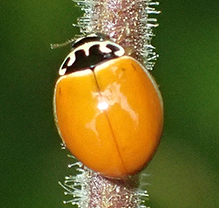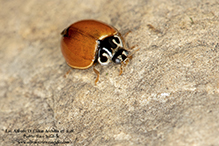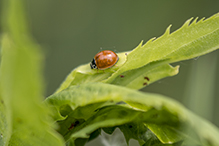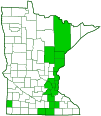Polished lady beetle
(Cycloneda munda)
Conservation • Description • Habitat • Ecology • Distribution • Taxonomy
Conservation Status |
|||
| IUCN Red List | not listed |
||
| NatureServe | NNR - Unranked |
||
| Minnesota | not listed |
||
Description |
Polished lady beetle is a small ladybird beetle. It occurs in most of North America from southern Canada to northern Mexico. It is common in the east, including the eastern half of Minnesota, less common in the Great Plains, uncommon in the arid southwest. The body is almost round, very convex, ⅛″ to ¼″ (3.7 to 5.7 mm) long, and ⅛″ (3.1 to 4.2 mm) wide. The head is shallowly inserted into the thorax, but is visible from above. The top of the head (vertex) and the compound eyes are black. The orbital groove, on the face bordering the compound eye, is white. On the male, the face is white. On the female, it is black. The upper thoracic plate (pronotum) is convex, wider than long, and distinctly margined on the sides. It is mostly black with white front and lateral margins. On each side near the head there is an outward-curved white mark that, together with the curved white lateral margin, forms a ring that is not completely closed. There is also a short white line in the middle that merges with the front white margin. The surface of the pronotum is leathery, covered with minute cracks, and dull, not shiny. The exoskeletal plate between the wing bases (scutellum), is small, triangular, and black. On the underside of the thorax, the rear margin of the first segment (prosternum) is rounded, not protruding, and the front margin of the second segment (mesosternum) is truncate, not deeply notched. The hardened wing covers (elytra) are reddish-orange and entirely free of spots. They completely cover the abdomen. The outer margins are weakly extended horizontally. The surface does not have grooves or rows of punctures. Rare individuals will have one or more black spots, but these are not arranged symmetrically. They are due to damage to the developing pupa. The legs are light yellowish-brown. The fourth segment (tibia) on the middle and hind legs have two spurs at the tip. The last part of each leg (tarsus), corresponding to the foot, has four segments, but the third segment is very short and tucked within the extended lobes of the second segment, making the leg appear to have only three segments. The tip of the last tarsal segment on the middle and hind legs has a pair of claws. Each claw has a large tooth at the base that is nearly square with rounded corners. |
Size |
Total length: ⅛″ to ¼″ (3.7 to 5.7 mm) |
Similar Species |
Habitat |
|
Ecology |
Season |
Spring and summer |
Behavior |
|
Life Cycle |
|
Larva Food |
|
Adult Food |
Aphids |
Distribution |
||
|
Sources Biodiversity occurrence data published by: Minnesota Biodiversity Atlas (accessed through the Minnesota Biodiversity Atlas Portal, bellatlas.umn.edu, 8/27/2025). |
|
| 8/27/2025 | ||
Occurrence |
||
|
||
Taxonomy |
|
Order |
Coleoptera (Beetles) |
Suborder |
Polyphaga (Water, Rove, Scarab, Long-horned, Leaf, and Snout Beetles) |
Infraorder |
Cucujiformia |
Superfamily |
Coccinelloidea (lady, fungus, scavenger, and bark beetles) |
Family |
|
Subfamily |
Coccinellinae (common lady beetles) |
Tribe |
Coccinellini (black-spotted lady beetles) |
Genus |
Cycloneda (spotless lady beetles) |
Subordinate Taxa |
|
|
|
Synonyms |
|
Coccinella sanguinea var. munda Cycloneda sanguinea var. munda |
|
Common Names |
|
immaculate lady beetle polished lady beetle |
|
Glossary
Elytra
The hardened or leathery forewings of beetles used to protect the fragile hindwings, which are used for flying. Singular: elytron.
Pronotum
The exoskeletal plate on the upper side of the first segment of the thorax of an insect.
Scutellum
The exoskeletal plate covering the rearward (posterior) part of the middle segment of the thorax in some insects. In Coleoptera, Hemiptera, and Homoptera, the dorsal, often triangular plate behind the pronotum and between the bases of the front wings. In Diptera, the exoskeletal plate between the abdomen and the thorax.
Tarsus
On insects, the last two to five subdivisions of the leg, attached to the tibia; the foot. On spiders, the last segment of the leg. Plural: tarsi.
Tibia
The fourth segment of an insect leg, after the femur and before the tarsus (foot). The fifth segment of a spider leg or palp. Plural: tibiae.
Visitor Photos |
Share your photo of this insect. |
||
This button not working for you? |
||
Babette Kis |
 |
Cycloneda munda polished ladybird beetle Cycloneda munda, polished ladybird beetle, photographed on Barnes Prairie, Racine Co., WI on June 23, 2021. |
Alfredo Colon |
 |
MinnesotaSeasons.com Photos |
 |

Slideshows |
|

Visitor Videos |
Share your video of this insect. |
||
This button not working for you? |
||
|
Other Videos |
Polished Lady Beetle eating, cleaning, and exposing wings (Cycloneda munda) |
About
ublished on Oct 23, 2016 Adults and larvae feed on those pesky aphids. Guest appearances by an Ambush Bug and an Assassin Bug. Coleoptera (Beetles) » Polyphaga (Water, Rove, Scarab, Long-horned, Leaf, and Snout Beetles) » Series Cucujiformia » Coccinelloidea » Coccinellid group » Coccinellidae (Lady Beetles) » Coccinellinae » Cycloneda (Spotless Lady Beetles) » Cycloneda munda (Polished Lady Beetle) Music: Sleeping Sheep |
Polished Lady Beetle eating, cleaning, and exposing wings (Cycloneda munda) |
About
ublished on Oct 23, 2016 Adults and larvae feed on those pesky aphids. Guest appearances by an Ambush Bug and an Assassin Bug. Coleoptera (Beetles) » Polyphaga (Water, Rove, Scarab, Long-horned, Leaf, and Snout Beetles) » Series Cucujiformia » Coccinelloidea » Coccinellid group » Coccinellidae (Lady Beetles) » Coccinellinae » Cycloneda (Spotless Lady Beetles) » Cycloneda munda (Polished Lady Beetle) Music: Sleeping Sheep |
Polished Lady Beetle (Coccinellidae: Cycloneda munda) on Leaf |
About
Published on Aug 7, 2010 An very small specimen, I think. Photographed at Itasca State Park, Minnesota (06 August 2010). |

Visitor Sightings |
Report a sighting of this insect. |
||
This button not working for you? |
||
| Babette Kis 6/23/2021 |
Location: Barnes Prairie, Racine Co., WI Cycloneda munda, polished ladybird beetle, photographed on Barnes Prairie, Racine Co., WI on June 23, 2021. |
 |
| Alfredo Colon 7/17/2018 |
Location: Woodbury, Minnesota |
 |
MinnesotaSeasons.com Sightings |

|
Created: 3/3/2019 Last Updated: © MinnesotaSeasons.com. All rights reserved. |
